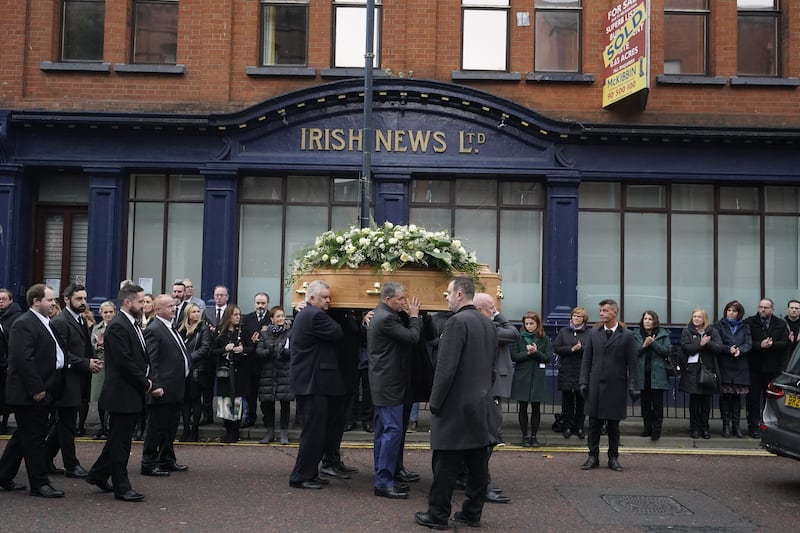More than 30 years ago, standing outside my mother’s shop on the Falls Road at the corner of Rockville Street, I was watching a march go by.
Almost all of the demonstrations, commemorations, protests passed the front door, the hunger strikes of the early 80s, the Easter parades and the funerals on their way to Milltown cemetery.
On several occasions, I saw someone I knew but had never met, although I did subsequently meet and talk to him for a 1992 book called Irish Olympians. Less than 5ft 4in’, he wasn’t a big man. A flyweight boxer with red hair and a wiry fame, he stood out as he kept up with the march, cameras slung over his shoulder.
Everybody knew who he was because not so many years before he had won a bronze medal at flyweight at the Moscow Olympic Games. Belfast loves its boxers.
READ MORE
Hugh Russell, a photographer for the Irish News, was from the New Lodge area, an enclave north of Belfast’s city centre and a working-class Catholic community that seemed to suffer at every turn.
Twenty years before Russell was born, it was heavily damaged in the Belfast blitz of 1941, when streets were torn apart as bombs concentrated on the nearby factories, mills and army barracks.
Burke Street was completely levelled and all who lived there killed. The area had a history of Irish republicanism and was surrounded by loyalist areas. It saw regular violence and in the early 1970s the flashpoint at Duncairn Gardens became a byword for volatility, disorder and death.
From that troubled area Russell emerged from The Holy Family club at 19-years-old as one of Ireland’s most talented boxers, having joined the club as a scrawny seven-year-old. He weighed in at three stone seven pounds, having fibbed that he was 11, the age limit to join.
“He told me lies for about three years,” coach Gerry Storey told the Irish News. “He was going on for 11 all that time.”
Travelling to Moscow for the Olympic Games with six others, including soon-to-be professional world champion Barry McGuigan, Russell would have understood more than most the political complexities of the USSR’s invasion of Afghanistan and the subsequent boycott of the 1980 Games by over 40 nations.
In Irish Olympians he spoke about his bronze-medal winning fight and the conversation he had before the bout.
“I remember fighting really tall men in the first couple of fights and saying to our team coach Gerry Storey after he told me we were fighting a Korean, ‘that’s great, at least I’ll be getting a wee man’.
“Out comes this Korean and he was 6ft 1in. For a flyweight who is more than nine inches smaller, the contest was tactically crucial. Gerry told me all I had to know about that man. As far as I was concerned the South Korean in the other corner was the biggest bastard in the world.”

Storey, now a chipper 87-years-old and still involved with boxing, offered hope to kids in the bleak 70s, 80s and 90s. His ecumenical passion saw him travel to Long Kesh, where he coached both republican and loyalist prisoners. That bold devotion to reaching out would have rubbed off on his protege Russell.
He was of New Lodge but bigotry was far from how Russell lived his life. In a passage from his wonderful book In Sunshine or in Shadow: How Boxing Brought Hope in the Troubles, Donald McRae explains how the sport was able to somehow transcend the tribal killing and put a stay on religious enmities.
Two of Storey’s most talented boxers, Hugh Russell and Davy Larmour, came from different sides of the divide, Russell a Catholic and Larmour from the Shankill.
[ Who shot my 14-year-old brother Peter in 1973?Opens in new window ]
The two rivals famously met in the ring on a brutal night in 1982 at the Ulster Hall. Russell won the fight but both boxers were badly hurt and required medical attention. Larmour, who drove a taxi by night, was pulling on his jacket ready to leave when an official came into the changing room. McRae describes the scene.
“Davy, how are you getting up to the hospital?” asked the man.
“I’m driving,” said Larmour.
“Would you take Hugh?” the official asked.
“Aye, no problem,” said Larmour.
On the way through Belfast, the pair joked about being stopped at a British army checkpoint and imagined the confusion of the soldiers, a beaten-up Protestant driving to the hospital with a bloodied Catholic lying on the back seat. When they left, Larmour had a dozen stitches, the winner Russell got 30.
We met again a few years ago for a newspaper article. He was now Hugh. Hugh drove from the city centre to my old house on the Falls Road, where I had first seen him in the 1980s. I was the subject, he the photographer and although we were the same age, I was in awe of this no fuss Olympic medalist taking pictures, giving gentle instruction.
Under my bedroom window a mural of blanket man Kieran Nugent had been painted. As a child I gazed out the window at what used to be Quinn’s Chemist wall, on a depiction of the IRA attack at Warrenpoint, where 18 British soldiers were killed. Standing here again I wondered about what troubled recollections Hugh would have had from 40 years of taking pictures around Belfast.
Those that knew him well say it didn’t subvert his gentle, accommodating nature. His legacy is of other images; being shouldered through the streets of the New Lodge, the red-headed kid with an Olympic medal brightening shredded streets. Good memories. Hugh died on October 13th, aged 63.
















